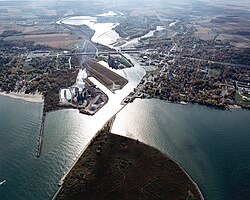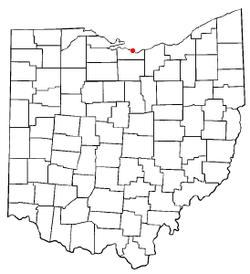Huron, Ohio
Huron, Ohio | |
|---|---|
 Aerial Photograph of Huron, Ohio, looking due south | |
| Motto: "A Great Lake Place." | |
 Location of Huron, Ohio | |
| Country | United States |
| State | Ohio |
| County | Erie |
| Government | |
| • Type | Council-manager |
| • City manager | Andrew D. White |
| Area | |
• Total | 7.7 sq mi (20.0 km2) |
| • Land | 4.9 sq mi (12.7 km2) |
| • Water | 2.8 sq mi (7.4 km2) |
| Elevation | 584 ft (178 m) |
| Population (2000) | |
• Total | 7,958 |
| • Density | 1,628.6/sq mi (628.8/km2) |
| Time zone | UTC-5 (Eastern (EST)) |
| • Summer (DST) | UTC-4 (EDT) |
| ZIP code | 44839 |
| Area code(s) | 419 and 567 |
| FIPS code | 39-37016Template:GR |
| GNIS feature ID | 1056347Template:GR |
| Website | http://www.cityofhuron.org/ |
Huron is a city in Erie County, Ohio, United States. The population was 7,958 at the 2000 census. It is part of the Sandusky, Ohio Metropolitan Statistical Area.
History and culture
Huron was at the center of the "Firelands" of the Connecticut Western Reserve, lands offered to residents of Connecticut who had lost property to British raiders during the American Revolutionary War. The first settler in the area that became Huron was a Quebec-born trapper, trader and interpreter named John Baptiste Flemmond, who established a trading post along the east bank of the Huron River in 1792.
Huron Township as well as the village of Huron were incorporated in 1809. Port facilities on the west bank of the Huron River were developed in the 1820s and the town became a major ship building center in the 1830s. The Wheeling and Lake Erie Railroad greatly expanded Huron's port on the east bank of the Huron River beginning in 1880. The first cargo of iron ore at the W&LE docks was received May 21, 1884. The port is still in use today, accepting cargoes of iron ore and limestone from lake freighters. Huron was also the home port of several commercial fishing fleets before lake pollution decimated the industry on Lake Erie in the early 1970s.
Commercial and industrial development had historically been centered around the port area. By the early 1960s a busy downtown business district had developed, serving local residents and summer tourists. However, with improvements to U.S. Route 6 and Ohio Route 2 bypassing the downtown area and enabling quicker travel to larger neighboring cities, downtown Huron went into decline. Starting in 1967, the City of Huron embarked on a controversial urban renewal program with funding from the U.S. federal government. The city purchased, in some cases by eminent domain, and demolished 38 commercial buildings and private homes. It then built a municipal marina, called the Huron Boat Basin, as the focal point of a new downtown. While the "Boat Basin" has become a popular community park and gathering place, extensive redevelopment of the downtown area did not occur as envisioned. New industry and commercial development has more recently occurred on the southern and western city limits.
BGSU Firelands, a branch campus of Bowling Green State University, is located just west of the city limits. A separate college of the Bowling Green State University system, BGSU Firelands has been a regional campus of BGSU since 1968. Over 2,000 students in 2006 were enrolled for a wide array of associate, bachelors and graduate degree programs.
Huron is the home of the Huron Playhouse, a division of the Bowling Green State University Department of Theatre and Film. The Huron Playhouse, which holds plays in the auditorium of McCormick Middle School, is Ohio's oldest continuing summer theatre.
The ConAgra Project
On July 18, 2006, the Ohio Department of Natural Resources (ODNR) announced the purchase of the ConAgra Foods facility in Huron. Concurrently, ConAgra Foods announced the closure of the grain elevator. The 19.8-acre (80,000 m2) parcel, containing Huron's largest building, is a key piece of Huron’s waterfront. ODNR's Division of Watercraft has completed a public boating and fishing access site with launch ramps, docks and parking facilities. The City of Huron has assumed title to the former grain silos and flour mill and has applied for a grant to demolish the building. It envisions a future riverfront development to include restaurants, retail stores, condominiums and greenspace.
On January 8, 2012, much of the former Con-Agra building was demolished by implosion in a public event attracting media attention and a large crowd. The former grain silos are being removed by manual demolition.
Geography
Huron is located at 41°23′59″N 82°33′54″W / 41.39972°N 82.56500°W (41.399669, -82.564974)Template:GR.
According to the United States Census Bureau, the city has a total area of 7.7 square miles (20 km2), of which 4.9 square miles (13 km2) is land and 2.8 square miles (7.3 km2) (36.87%) is water.
Demographics
As of the censusTemplate:GR of 2000, there were 7,958 people, 3,315 households, and 2,260 families residing in the city. The population density was 1,628.6 people per square mile (628.3/km²). There were 3,832 housing units at an average density of 784.2 per square mile (302.6/km²). The racial makeup of the city was 97.37% White, 0.70% African American, 0.18% Native American, 0.53% Asian, 0.40% from other races, and 0.82% from two or more races. Hispanic or Latino of any race were 1.63% of the population.
There were 3,315 households out of which 30.9% had children under the age of 18 living with them, 55.6% were married couples living together, 9.7% had a female householder with no husband present, and 31.8% were non-families. 27.6% of all households were made up of individuals and 10.4% had someone living alone who was 65 years of age or older. The average household size was 2.37 and the average family size was 2.92.
In the city the population was spread out with 25.0% under the age of 18, 6.1% from 18 to 24, 28.2% from 25 to 44, 25.5% from 45 to 64, and 15.2% who were 65 years of age or older. The median age was 39 years. For every 100 females there were 91.9 males. For every 100 females age 18 and over, there were 88.9 males.
The median income for a household in the city was $52,289, and the median income for a family was $68,625. Males had a median income of $50,105 versus $27,637 for females. The per capita income for the city was $24,942. About 2.7% of families and 3.6% of the population were below the poverty line, including 4.0% of those under age 18 and 5.6% of those age 65 or over.
Sports
Huron City Schools sports teams are known as the Tigers. The Tigers have recorded numerous athletic successes for both boys and girls. The Tigers won the 2004-2005 Boys Sandusky Bay Conference (SBC) All Sports Award with conference championships in
- Basketball
- Track and Field
- Soccer
- Football
- Tennis
The Lady Tigers have recorded success in volleyball under coach Don Wood, with ten consecutive SBC championships, including Division III State titles in 1999, 2002 and 2009 and State runner-up in 2001.

